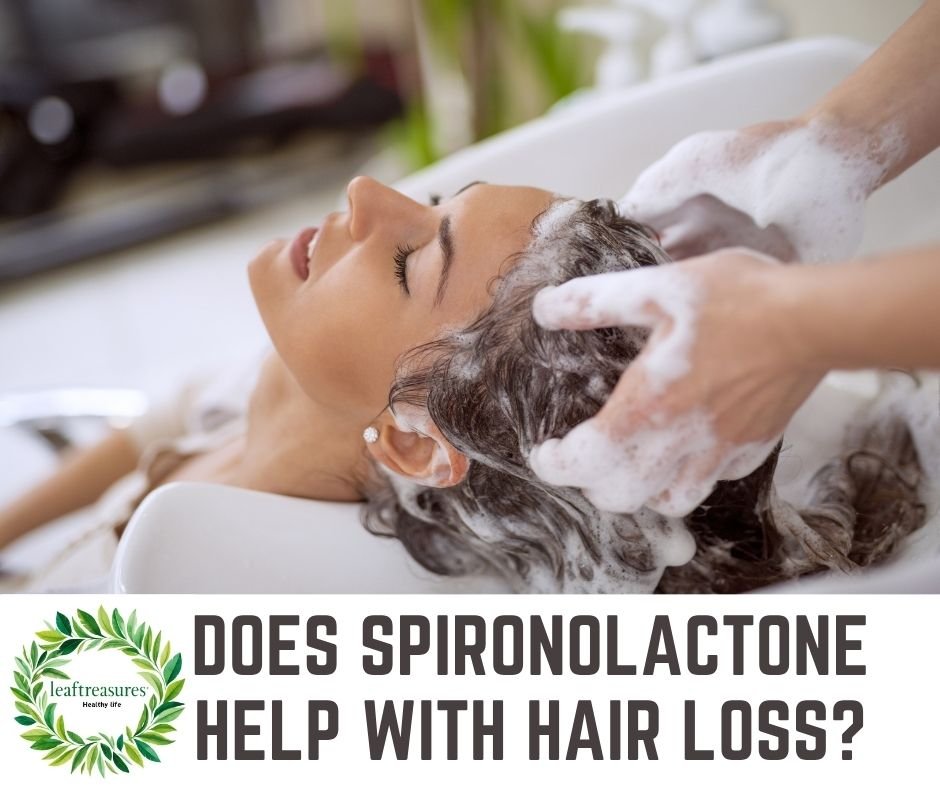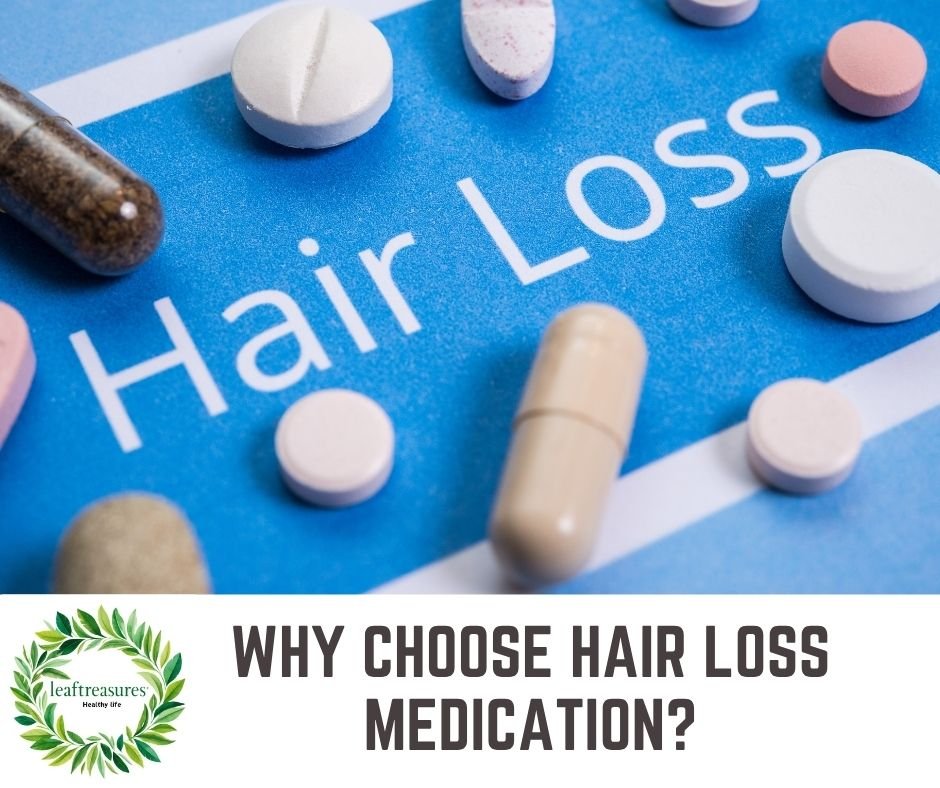Don't miss our holiday offer - up to 50% OFF!
Help with Hair Loss: Discover over 5 new treatments
Are you standing in front of the mirror, worried about your thinning hairline or the silently enlarging “blank zone” on your scalp? Help with Hair Loss starts here—from uncovering the root causes to selecting science-medical treatment, this article will guide you through.
Hair loss, a seemingly minor yet confidence-shattering issue, has quietly become a major concern for modern people.
From the subtle effects of androgen infestations to the subtle effects of fungal infections, from the hidden threat of nutritional imbalances to the chain reaction of overwhelming stress, the complex scientific code behind hair loss lies.
But don’t worry, medical advances have unlocked a variety of weapons—from the vasodilator minoxidil to the androgen-suppressing finasteride, from the antifungal ketoconazole to hormone-regulating HRT, and even cross-disciplinary players like spironolactone have entered the fray.
This article will pierce the fog and uncover the truth about medical treatments for hair loss: Which medications can truly stop hair loss and promote hair growth? How do they work? How can you choose the best option for you? The answers are here.

What Is Medical Treatment for Hair Loss?
Hair loss medications refer to treatments that use oral or topical medications to regulate hormone levels, improve the hair follicle microenvironment, or promote hair growth, with the goal of slowing hair loss, increasing hair density, or restoring hair growth.
The core principle of these treatments is to address the primary causes of hair loss (such as hormonal effects, hair follicle atrophy, and circulatory disorders). They are suitable for various types of hair loss, including androgenic alopecia and alopecia areata.
Which Medications Can Treat Hair Loss?
Pharmaceuticals play a crucial role in the treatment of hair loss and are a top priority for many individuals experiencing hair loss.
Currently, a variety of medications are available for hair loss treatment. For example, the topical medication minoxidil dilates scalp blood vessels, increasing blood supply to hair follicles and stimulating hair growth. Finasteride, an oral medication, inhibits the activity of androgens in the body that contribute to hair loss, reducing hair loss.
However, pharmaceutical treatments also have limitations. Individuals react differently to medications, and some medications may have side effects, such as skin allergies and impaired sexual function. Therefore, Generally speaking, when using drugs to treat hair loss, we usually do so under the guidance of a dermatologist. We need to strictly follow the doctor’s instructions and requirements to use drugs or other methods to treat hair loss.

Does Nizoral Help with Hair Loss?
Nizoral (ketoconazole) has a certain auxiliary therapeutic effect on hair loss, but it is not a direct hair growth drug. Its mechanism of action and clinical application are as follows:
As an imidazole antifungal agent, ketoconazole effectively combats fungal pathogens like Malassezia on the scalp. Fungal overgrowth can trigger inflammation, damaging hair follicles and exacerbating hair loss. By eradicating fungi and reducing scalp inflammation, ketoconazole creates a healthier environment for hair growth, thereby helping to help with hair loss in cases linked to microbial imbalance.
Additionally, research indicates that ketoconazole may inhibit cytochrome P450 enzymes, disrupting steroid synthesis and lowering systemic androgen levels (e.g., dihydrotestosterone, or DHT). Since DHT is a primary driver of androgenetic alopecia (AGA), this mechanism suggests ketoconazole could further help with hair loss by slowing DHT-mediated follicle miniaturization.
#1:Clinical Applications
Ketoconazole is widely formulated as a shampoo (e.g., Nizoral Shampoo, 1% ketoconazole) to help with hair loss by targeting scalp fungal infections. Clinical studies demonstrate that using a 2% ketoconazole shampoo two to four times weekly for 21 weeks significantly increases hair density, enlarges follicle size, and boosts the proportion of anagen (growth-phase) follicles, thereby improving hair retention.
#2:Combination Therapy
In European and U.S. hair loss protocols, ketoconazole is frequently combined with finasteride (DHT inhibitor) and minoxidil (hair growth promoter) to form the “big three” regimen. This multi-targeted approach synergistically helps with hair loss by addressing fungal inflammation, hormonal triggers, and vascular supply simultaneously, enhancing overall treatment efficacy.
#3:Precautions
Indications: Ketoconazole shampoo is primarily indicated as an adjunctive therapy to help with hair loss associated with fungal infections (e.g., seborrheic dermatitis, dandruff) or androgenic alopecia. However, its effectiveness may be limited for hair loss caused by genetic factors or nutritional deficiencies.
Usage: Apply the shampoo 1–3 times weekly, leaving it on the scalp for 3–5 minutes to ensure efficacy. Oral ketoconazole is rarely prescribed for hair loss due to risks of hepatotoxicity.
Individual Differences: Sensitivity to ketoconazole may cause scalp irritation or itching. If symptoms persist or worsen, consult a physician promptly to adjust the treatment plan.

Does Folic Acid Help with Hair Loss?
The mechanism of action of folic acid and hair loss is related.
Folic acid serves as a crucial coenzyme for cell division and DNA synthesis. The proper proliferation of hair follicle cells relies on a sufficient supply of folic acid. A long-term deficiency in folic acid can impede the renewal of hair follicle cells, potentially contributing to hair loss. Nevertheless, it’s important to note that the mechanisms behind hair loss are intricate, and while ensuring adequate folic acid intake may help with hair loss to some extent, a single nutrient cannot fully resolve this complex issue.
Folic acid might indirectly help with hair loss by stimulating red blood cell production and enhancing scalp microcirculation, which in turn delivers more nutrients and oxygen to hair follicles. However, achieving this effect necessitates the combination of other nutrients.
Folic acid deficiency can cause megaloblastic anemia, resulting in inadequate nutrient delivery to hair follicles and subsequent hair loss. Supplementing with folic acid can help with hair loss caused by this type of anemia by improving the condition, though a blood test is necessary to confirm the specific type of anemia.
How effective is folic acid for different types of hair loss?
- Nutritional hair loss: If hair loss is caused by deficiencies in nutrients such as protein, iron, and zinc, folic acid supplementation may have a certain auxiliary effect, but the other deficiencies must be addressed simultaneously.
- Androgenic alopecia: Primarily related to genetics and androgen levels, folic acid has limited preventive effects for this type of hair loss and requires combined treatment with medications such as finasteride and minoxidil, or hair transplantation.
- Alopecia areata: Caused by the immune system attacking hair follicles, folic acid cannot interfere with this immune process and requires treatment with glucocorticoids or immunomodulators.
- Stress-induced alopecia: Folic acid may indirectly protect hair follicles by participating in glutathione synthesis and reducing oxidative stress. However, this requires a regular sleep schedule and stress reduction measures.
- Physiological hair loss during pregnancy: Folic acid needs increase during pregnancy. Moderate supplementation can prevent hair loss caused by folic acid deficiency, but this should be done under a doctor’s supervision.
What precautions should be taken when using folic acid?
Individual Differences: The degree to which folic acid can help with hair loss varies among individuals, and blood tests are essential to confirm any deficiency. Excessive supplementation might not only fail to help with hair loss but could also mask symptoms of vitamin B12 deficiency or impose a strain on the kidneys.
Comprehensive Treatment: Addressing hair loss necessitates targeting the underlying cause with appropriate treatments, such as medication for androgenic alopecia and immunotherapy for alopecia areata. While folic acid can play a supportive role and help with hair loss to some extent, it should serve only as an adjunct and not replace professional medical treatment.
Lifestyle Adjustments: Making lifestyle changes, such as maintaining a balanced diet rich in dark green vegetables, beans, and animal liver, adhering to a regular sleep schedule, and minimizing perming, dyeing, and mechanical tension on the hair, are crucial strategies that can significantly help with hair loss prevention.

Does Hrt Help with Hair Loss?
Hormone Replacement Therapy (HRT) may help with hair loss in specific cases, particularly when hair loss is caused by declining estrogen levels, but its effectiveness depends on individual circumstances and requires careful risk assessment.
- Mechanisms and Target Populations
Menopausal Hair Loss: Women experiencing menopause often face a sharp drop in estrogen, which can weaken hair follicles, leading to thinning or shedding. HRT, by supplementing estrogen (e.g., estradiol) and progesterone, may help restore hormonal balance and mitigate hair loss linked to estrogen deficiency. Studies suggest HRT could slow down or halt this type of hair loss in some cases.
Androgenic Alopecia (Female Pattern): For women with elevated androgens (e.g., due to polycystic ovary syndrome), HRT’s progesterone component may counteract androgenic effects, indirectly helping with hair loss. However, HRT is not a first-line treatment for androgenic alopecia; anti-androgens (e.g., spironolactone) or minoxidil are typically more effective.
- Efficacy and Limitations
Variable Outcomes: The degree to which HRT helps with hair loss varies based on hormone levels,hair loss type, and duration. Some patients may notice improved hair density or reduced shedding, but results are not guaranteed and require long-term use to sustain benefits.
Not a Universal Solution: Hair loss stems from diverse causes (genetics, nutrition, stress, autoimmune conditions). HRT only addresses hormonal imbalances. If hair loss is driven by non-hormonal factors, HRT may not help, necessitating combined therapies (e.g., medications, PRP, or lifestyle changes).
- Risks and Precautions
Potential Side Effects: HRT is associated with increased risks of breast/ovarian cancer, endometrial cancer, blood clots, and cardiovascular issues. Long-term use demands regular monitoring of breast, uterine, and heart health.
Contraindications: HRT is unsuitable for individuals with a history of hormone-related cancers, severe liver/kidney dysfunction, or thrombotic disorders. Prior evaluation (pelvic exams, mammograms, cardiovascular assessments) is essential to determine eligibility.
Alternatives: If HRT risks outweigh benefits, topical treatments (e.g., minoxidil), oral anti-androgens, or non-pharmacological options (low-level laser therapy, microneedling) may offer safer alternatives to help with hair loss.
- Comprehensive Management Strategies
Diagnose the Root Cause: Hair loss treatment should begin with blood tests, hormone panels, and scalp examinations to identify underlying triggers.
Combine Therapies: While HRT may help with hair loss in hormonal cases, adjunct approaches like a balanced diet (rich in protein, iron, zinc, and B vitamins), avoiding chemical treatments, and stress reduction enhance outcomes.
Regular Follow-Ups: Patients on HRT must attend periodic check-ups to adjust dosages and monitor side effects, ensuring safe and effective management of hair loss.

Does Spironolactone Help with Hair Loss?
Spironolactone, an aldosterone antagonist originally developed for hypertension and edema, has demonstrated efficacy in helping with hair loss associated with androgenic alopecia (AGA), particularly in women. However, its effectiveness depends on the underlying cause of hair loss and requires careful medical supervision.
- Mechanism of Action and Target Populations
Anti-Androgenic Properties: Spironolactone helps with hair loss by inhibiting androgen synthesis and blocking androgen receptors in hair follicles. This reduces the impact of dihydrotestosterone (DHT), a hormone linked to follicular miniaturization in androgenic alopecia.
Ideal Candidates:
Women with AGA: Studies show spironolactone can help with hair loss in women experiencing female pattern hair loss, improving hair density and thickness when used consistently.
Men with AGA: Use in men is controversial due to risks of gynecomastia, sexual dysfunction, and hormonal imbalances. It is rarely prescribed as a first-line treatment.
Contraindications: Patients with renal impairment, hyperkalemia, or a history of hormone-sensitive cancers should avoid spironolactone.
- Efficacy and Limitations in Helping with Hair Loss
Women: Randomized trials indicate that spironolactone, when combined with topical minoxidil, significantly helps with hair loss in women with AGA, with measurable improvements in hair count and diameter after 6–12 months.
Men: Limited data suggest minimal benefit, and side effects often outweigh potential gains.
Non-Androgenic Hair Loss: Spironolactone does not help with hair loss caused by telogen effluvium, alopecia areata, or scarring alopecia.
Slow Onset: It typically takes 3–6 months to observe noticeable improvements, and long-term use is often necessary to sustain results.
- Usage Guidelines for Optimal Results
Starting Dose: 50–100 mg/day for women, adjusted based on tolerance and lab results (e.g., potassium levels).
Combination Therapy: Spironolactone is often prescribed alongside minoxidil or low-level laser therapy to enhance its ability to help with hair loss.
Common Risks: Hyperkalemia, menstrual irregularities, and breast tenderness. Regular blood tests are essential to monitor electrolyte balance and renal function.
Patient Education: Counseling on dietary potassium restrictions and symptom tracking (e.g., irregular periods) is critical.
- Alternative Treatments When Spironolactone Is Unsuitable
Minoxidil: A topical vasodilator that helps with hair loss by prolonging the anagen phase of hair growth, suitable for both men and women.
Finasteride: An oral 5α-reductase inhibitor prescribed for male AGA, though it carries risks of sexual dysfunction.
Non-Pharmacological Approaches:Platelet-Rich Plasma (PRP): Injections of autologous growth factors stimulate dormant follicles and may help with hair loss in early-stage AGA.
Hair Transplantation: Surgical redistribution of follicles from donor sites to balding areas provides permanent results for eligible candidates.
- Comprehensive Management Strategies
- Diagnose the Cause: Hair loss evaluation should include trichoscopy, blood tests (e.g., ferritin, thyroid hormones), and scalp biopsies to identify reversible triggers.
- Diet: Ensure adequate intake of protein, iron, zinc, and biotin through foods like lean meats, leafy greens, and nuts.
- Hair Care: Avoid chemical treatments, tight hairstyles, and heat styling to minimize traction alopecia.
- Psychological Support: Address anxiety or depression related to hair loss through counseling or support groups.
Spironolactone can effectively help with hair loss in women with androgenic alopecia when used as part of a personalized treatment plan. However, its risks necessitate thorough evaluation and ongoing monitoring. For non-androgenic or advanced hair loss, alternative therapies may offer better outcomes.

Does Minoxidil Help with Hair Loss?
Yes, minoxidil is clinically proven to help with hair loss, particularly in androgenic alopecia (AGA) and alopecia areata. Its efficacy stems from its ability to stimulate hair growth through multiple mechanisms. Below is a detailed analysis of its role in treating hair loss.
1.How Minoxidil Helps with Hair Loss?
Minoxidil acts as a potent vasodilator, relaxing smooth muscle cells in scalp blood vessels. This increases blood flow to hair follicles, delivering essential nutrients (e.g., oxygen, amino acids) and growth factors. Enhanced circulation helps with hair loss by:
a. Vasodilation and Improved Blood Flow
- Reducing follicular hypoxia (oxygen deprivation), a common cause of miniaturization in AGA.
- Supporting the transition of dormant follicles into the active growth phase (anagen).
b. Prolongation of the Anagen Phase
Minoxidil extends the anagen (growth) phase of the hair cycle while shortening the telogen (resting) phase. By delaying follicular regression, it helps with hair loss by:
- Increasing hair shaft diameter and density.
- Preventing premature shedding of mature hairs.
c. Upregulation of Growth Factors
Minoxidil stimulates the production of vascular endothelial growth factor (VEGF) and insulin-like growth factor-1 (IGF-1) in dermal papilla cells. These cytokines promote follicular proliferation and differentiation, directly contributing to its ability to help with hair loss.
2.Which Types of Hair Loss Does Minoxidil Help With?
a. Androgenic Alopecia (AGA)
Minoxidil is a first-line treatment for male and female pattern hair loss. Key findings include:
5% topical solution: More effective than 2% in increasing hair count and thickness (studies show a 45% greater improvement over placebo).
Onset of action: Visible results typically appear after 4–6 months of consistent use, with maximal benefits at 12 months.
Long-term use: Required to sustain results; discontinuation often leads to relapse within 3–6 months
b. Alopecia Areata
While not FDA-approved for this indication, minoxidil may help with hair loss in mild-to-moderate alopecia areata, particularly when combined with intralesional corticosteroids. Response rates vary, with some patients reporting regrowth in patchy areas.
c. Telogen Effluvium
Minoxidil can help with hair loss caused by telogen effluvium (e.g., postpartum, stress-induced) by accelerating the transition of telogen hairs back to anagen. However, addressing the underlying trigger (e.g., nutritional deficiencies, hormonal imbalances) is equally critical.

Why Choose Hair Loss Medication?
The primary goal of hair loss medication is to intervene in the hair loss process through scientific mechanisms, protecting or restoring hair follicle function. By doing so, these treatments help with hair loss by improving physical appearance, enhancing quality of life, and preventing further deterioration.
Early intervention in androgenic alopecia (AGA) can significantly slow the progression of hair thinning, helping to avoid severe patterns such as a “Mediterranean” or “M-shaped” hairline. Similarly, controlling alopecia areata (AA) in its initial stages can prevent the condition from advancing to total or universal alopecia, thereby increasing the likelihood of recovery and ensuring medication continues to help with hair loss effectively.
On the other hand, medication can actively promote hair regrowth and restore hair density. For example:
Minoxidil dilates scalp blood vessels, enhancing nutrient delivery to hair follicles. This process helps with hair loss by prolonging the anagen (growth) phase and shortening the telogen (resting) phase, leading to thicker, healthier hair.
Finasteride inhibits 5α-reductase, reducing dihydrotestosterone (DHT) production and blocking pathways that cause follicular miniaturization. By addressing hormonal triggers, it helps with hair loss in male pattern baldness.
These pharmacological approaches not only halt progression but also reverse damage, ensuring sustained benefits for patients.
Beyond physical improvements, hair loss medications help with hair loss by addressing its psychological and dermatological consequences:
Hair loss often leads to low self-esteem, anxiety, and social withdrawal, particularly among younger patients. By restoring hair volume and density, medications help with hair loss by boosting confidence and improving interpersonal relationships. Studies show that patients undergoing treatment report significant enhancements in mental health and overall quality of life.
Severe hair loss exposes the scalp to environmental risks, including UV radiation and microbial infections. Drug therapies help with hair loss by maintaining follicular integrity and preserving the scalp’s barrier function. This reduces complications such as sunburn, dermatitis, and secondary infections, ensuring long-term scalp health.
Hair loss medications serve a dual purpose: they help with hair loss by halting progression and stimulating regrowth while addressing associated psychological and physical risks. Early and consistent use maximizes their efficacy, offering patients a holistic solution to improve both appearance and well-being.

Article Summary
Hair loss treatment requires precise intervention based on the cause of the disease, and the combination of drug and non-drug therapies can significantly improve the effect.
Core conclusions:
- Drugs are the key means: minoxidil (vasodilation), finasteride (inhibits DHT), spironolactone (anti-androgen), etc. play a core role in different types of hair loss (androgenic alopecia, alopecia areata, etc.), but you must strictly follow the doctor’s instructions to avoid side effects.
- Combination therapy is better: for example, ketoconazole shampoo (antifungal) combined with finasteride and minoxidil can synergistically improve the hair follicle environment and enhance efficacy through multiple targets.
- Individualized treatment is important: the type of hair loss (genetic, hormonal, nutritional, etc.), gender, and tolerance need to be determined through testing (such as hormone levels and hair follicle examination) to avoid blind medication.
- Lifestyle is the basis: A balanced diet (supplemented with protein, iron, and zinc), stress reduction, avoiding chemical damage (perming and dyeing), and other auxiliary measures are essential for long-term management.
Recommended actions:
- Prioritize professional testing to determine the type of hair loss before selecting medication or combination therapy.
- Early intervention (such as initial medication for androgenic alopecia) can significantly slow progression.
- Adhere to long-term treatment with regular follow-up, and adjust the treatment plan based on effectiveness.
Hair loss treatment requires science, patience and comprehensive management. It starts with understanding scalp signals, choosing appropriate medications, and gradually restoring hair health.

